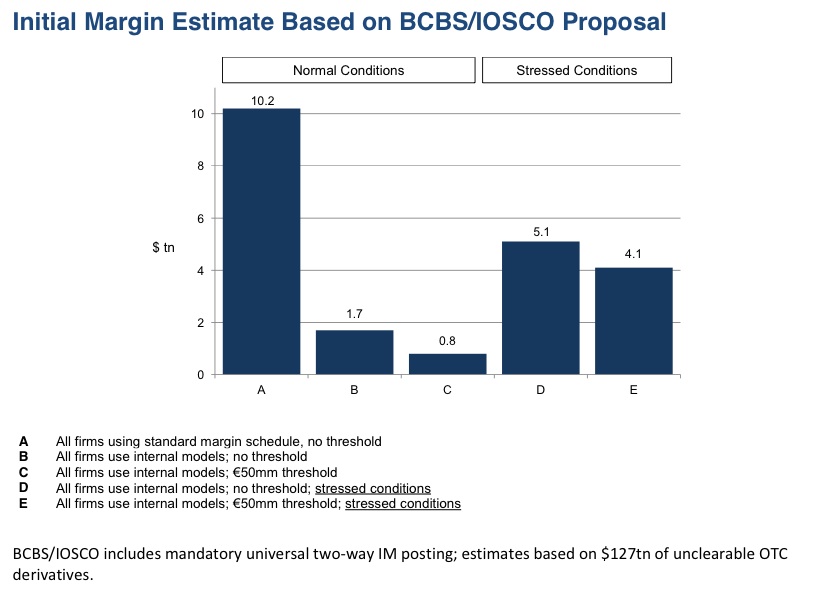On November 27, 2012 ISDA released a presentation entitled “Initial Margin For Non-Centrally Cleared Swaps, Understanding the Systemic Implications”. ISDA does a great job in highlighting the wide range of possible new initial margin requirements (IM) from regulations on non-cleared derivatives. They also warn of some pretty big systemic threats. But under the hood, we have some questions. Let’s take a look at what they actually said.
Regulators want derivatives to be centrally cleared. No surprises there. To encourage that, the plan is to mandate high IM on non-centrally cleared OTC derivatives. Some OTC derivatives are not going to be centrally cleared – either regulators agree they don’t need to be (like FX swaps and forwards) or are too complicated to fit into the standardized boxes built by CCPs.
ISDA’s premise is that to create “systemic resiliency”, there are three things to get right:
- Robust variation margin framework
- Mandatory clearing for liquid, standardized product
- Appropriate capital standards
Notice that ISDA’s definition does not include IM.
ISDA establishes that the non-cleared OTC derivatives market is important. They cite currency swaps, interest rate options, CDS, and bespoke derivatives as being crucial to a variety of market participants. As a kicker, they add that supranationals – IBRD, EBRD, EIB, etc. – use non-cleared swaps in their funding activities; setting up a regulator versus supranational throw-down.
Then come the numbers. Upwards of $10.2 trillion of IM could be necessary to support the estimated $127 trillion of non-cleared OTC derivatives under one regulatory scenario in normal market conditions. Depending on the model used and if there are thresholds (where only above that level will IM be required to actually be paid), the numbers vary down to $800 billion in still another regulatory scenario.
ISDA says that banks simply don’t have the “unencumbered assets available for delivery as margin”. The alternatives being that banks will have to “…generate incremental funding through the capital markets… divert funding from other activities (such as lending or market making) or… decrease or cease activity in non-cleared OTC markets…” ISDA, understandably, doesn’t like any of those choices.
When ISDA says that “…IM would be segregated and could not be used for any other purpose; funds used for IM could otherwise have been put to use by the bank in the economy, through lending and other activities” and “…at the global macroeconomic level, segregation of cash of the order of $800bn to $1.7tn is a form of extreme quantitative tightening at a time when monetary policy is generally oriented in the opposite direction…” it brings flashbacks on the impact of LSOC and other collateral segregation schemes. Banks have used that collateral to fund themselves, much like repo desk re-hypothecate the collateral they receive. Taking that liquidity out of the equation would shift derivatives pricing, perhaps making them uneconomic for some.
ISDA noted that IM could increase in times of financial stress, saying this was pro-cyclical (in a bad way) for the banking system and economy. One solution is to set either very high IM levels such that they would cover risk in times of stress, but this would result in such high funding needs that the market could shut down. Another alternative is to set low or zero IM levels. While ISDA accepted that potential future exposure would not be covered, they said that capital would cover the risk.
From our perch, we think that ISDA’s analysis is great but that their conclusions may fall on deaf ears. IM is there to cover risk in case the counterparty defaults and no longer is making variation margin payments. Eliminating IM is about as effective as arguing that haircuts in repo are not worth the effort. With the FSB banging the drum about mandatory minimum repo haircuts, we can imagine that ISDA’s pleadings will be seen as “nice try guys”.
Ultimately, isn’t reducing systemic risk by collateralizing exposures the benefit of regulatory reform? Why shouldn’t IM increase during times of stress? Haircuts on repo do (or should). It prompts deleveraging when markets need that to happen. If clients don’t maintain adequate resources to trade with higher IM amounts, should they be keeping the trade on (or be doing new ones)? Futures markets and centrally cleared repo (e.g. LCH RepoClear) can raise initial margin and it seems to work well (MF Global notwithstanding). And if ISDA gets their way and convinces regulators to permit banks to not raise IM when markets are stressed, then the exposure goes right to the banks. Don’t their CVA desks have to hedge it anyway? While ISDA may want to argue for no IM, we think they may want to try a middle ground approach from a lobbying point of view.
We think IM levels on straightforward non-cleared derivatives should be reasonable – not punitive simply because they aren’t cleared or zero because it will increase the cost of the trade. Inevitably the BIS or some other institution will look at the same data that ISDA used and come to the opposite conclusions. For as smart as they are and as good the work is that they do, that’s not the place that ISDA wants to be.
A link to the ISDA presentation is here


